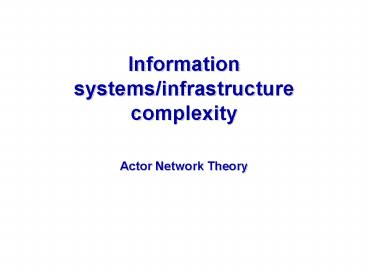Information systemsinfrastructure complexity - PowerPoint PPT Presentation
1 / 26
Title:
Information systemsinfrastructure complexity
Description:
Types og components, types of links, speed of change ... 'Immutable mobiles' Fluids ('mutable mobiles') Order's dis-order. Assumptions ... – PowerPoint PPT presentation
Number of Views:49
Avg rating:3.0/5.0
Title: Information systemsinfrastructure complexity
1
Information systems/infrastructure complexity
- Actor Network Theory
2
Basic concepts old and new
- System
- Tool
- Requirements specification
- Planning and control
- Modelling
- Iplementation
- Network
- Infrastructure
- Bootstrapping an installed base
- Flexible standards
- Lock-in
- Gateway
- Boomerang effects
3
Complexity
- Types og components, types of links, speed of
change - Unpredicable (or uncontrollable) interactions,
unpredicatable (or uncontrollable) outcomes - (propagation of) side-effects
4
Actor Network Theory
- Understanding heterogeneity interaction between
the social, technical, institutional, (humans
and non-humans/technological and
non-technological components) - Network of actants
- Origin Social studies of science
- The interaction between social, political,
technological, institutional elements in
construction of scientific facts and theories
(Kuhn) - The third way Between determinism and
constructivism
5
Actor Network Theory 2
- Theory/fact and technology heterogeneous network
- Science and and technological development
- Transforming/building networks
- Actors (heterogeneous) networks
6
Actors
- Always heterogeneous network
- No assumptions about differences between human
and technology - There ARE differences constructed - not given
- Inscriptions of rules and programs-of-action,
delegations of roles and competences, .. - Humans are different
- Technologies are different
- Ideal for studying interaction between humans,
organizations and technology (I.e. the role of
the technology. Compare with Orlikowskis
technological artefact/technology-in-use
distinction)
7
Concepts
- Actants
- Associations/networks/collectives (of humans and
non-humans) - Translation, composition, enrollment
- Interference
- Inscription, delegation
- Program-of-action
- Black-boxing
- Irreversibility
- Immutable mobiles
- Fluids (mutable mobiles)
- Orders dis-order
8
Assumptions
- Everything theories, facts, technologies,
humans are networks/collectives - Network building is a political process
- All actors have interests
- Building alliances
- Power strength size of the network
- The process is embedded in the product
9
Example Lab reports
- Lab reports - Furst
- Solution sequence of translations (of interests
and existing solutions and technologies) - Interests and translations
- More customers
- Better service
- Electronic transmission
- Specific design
10
Lab. orders - continued
- Integration with medical record system
- Giving away modems for free
- Integration with local practices
- For each translation the network (collective)
grows, alignment is maintained
11
Order
- Interests lab improved results -gt cost
containment --gt cut manual registration work
doctors ? patients security, vendors,
authorities, standardization bodies, standards,
????
12
Order continued...
- EDIFACT solution failed to enroll doctors
- Failed to align standardized solution and
doctors interests - First Post ordering
- Appears to be impossible to align with settled
standards
13
Prescriptions
- Social security cost containment more strict
control - Pharmacy Cutting manual registration work,
improved logistics - Patients Less waiting (reiterated prescriptions
?) - Physicians Quality control
- Failed to make a solution that anybody would pay
for - Failed in translating the interests into an
aligned network
14
More on Prescriptions
- Failed standardizationComplex socio-technical
networks (failed to understand the complex
network of relations between the social and the
technical) - Focused isolated on standardization
- Didnt address the need for translating
technology into use - Blind for interests
15
Design Making inscriptions
- of programs-of-action
- which one?
- How?
- Who?
- How strong is the inscription?
- Can users change it?
- Flexibility!!
16
Inscriptions in standards
17
Example Hotel keys (Latour)
- Problem Customers not returning keys
- Anti-programs
- 1. trial Sign behind the counter Please
remember to return the key - 2. trial Ordering the doorman to remind
customers - 3. trial Adding a metal nob to the key
- Inscribing building network
- Make it strong enough
18
Inscriptions in standards
- Materials
- The standards organizations
- Systems architecture
- EDIFACT syntax
- Messages
- Data elements
- The socio-technical network!
- The EDIFACT network Big and strong
19
Inscriptions in the EDIFACT actor network
- No user participation
- Must know the rules and the network
- The complexity of the network
- The EDIFACT mafia in control
- No flexibility
20
Systems architecture
- Message based, transaction oriented,
client/server, event-driven - EDIFACT message based (modelling paper forms) gt
email (X.400) - Labs
- Orders and complete reports
- Ordering new analysis
21
EDIFACT Syntax
- No sub typing gt no specialization
- General standard that includes everything
- Defining new subsets of this one
- New local needs must
- Be included in the general standards
- Defining new subsets
22
More on EDIFACT syntax
- Implications
- Low flexibility
- Centralized control
- Complexity
- gt aligned with inscriptions into the
standardization organization
23
Individual messages
- Data elements determines the use are of a message
- Economic data in lab messages? Support
administrative processes - References internally in a message?
- Including the order in the report?
- Huge amounts of date
- Complex definitions
- Order sometimes required
- Inscriptions in organization too strong
24
Data elements
- Identifying drugs in prescriptions
- Text?
- Code?
- Selecting identifiers
- Establishing organization?
- Extend GPs systems
- Distribution of new versions to GPs
25
Extending the network to increase its strength
- How to make GPs use the codes?
- Integration with EPR
- Integration with common catalogue?
- Extend the list with additional information?
- Quality assurance?
26
Technology as ally
- Vendors tried to ally themselves with a standard
to strengthen own position - HL-7, Medix, EDIFACT
- ...CEN
- The dept.s initiative was killed































